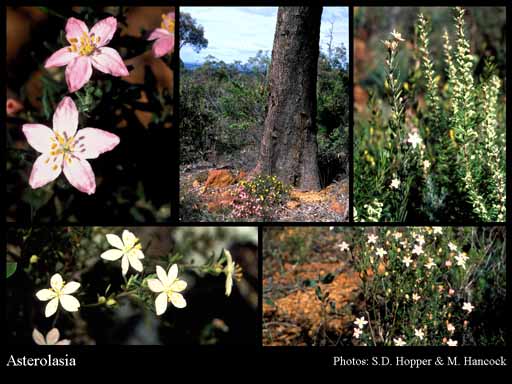- Reference
- Trans.Philos.Soc.Victoria 1:9 (1854)
- Name Status
- Current







Scientific Description
Family Rutaceae.
Habit and leaf form. Under- shrubs; evergreen, or deciduous; bearing essential oils. Mesophytic, or xerophytic. Leaves alternate; leathery, or ‘herbaceous’; petiolate; non-sheathing; gland-dotted; aromatic; simple. Leaf blades entire; pinnately veined, or one-veined. Leaves with stipules, or without stipules; without a persistent basal meristem. Leaf anatomy. Hairs present; complex hairs present. Complex hairs stellate. Stem anatomy. Nodes unilacunar, or tri-lacunar. Secondary thickening developing from a conventional cambial ring.
Reproductive type, pollination. Fertile flowers hermaphrodite. Unisexual flowers absent. Plants hermaphrodite. Entomophilous.
Inflorescence and flower features. Flowers aggregated in ‘inflorescences’; in umbels (subtended by leafy or petaloid bracts). The terminal inflorescence unit cymose, or racemose. Inflorescences terminal and axillary (apparently). Flowers bracteate; small to medium-sized; commonly fragrant; regular, or somewhat irregular. The floral asymmetry when noticeable, involving the perianth and involving the androecium (not K). Flowers 5 merous; cyclic. Floral receptacle developing a gynophore (associated with the disk), or with neither androphore nor gynophore. Free hypanthium absent. Hypogynous disk present (minute); intrastaminal; annular (sometimes one-sided), or of separate members. Perianth with distinct calyx and corolla, or petaline; 5, or 10; 1 -whorled, or 2 -whorled; isomerous. Calyx present (small), or vestigial (minute), or absent; 5; 1 -whorled; polysepalous, or gamosepalous; imbricate; regular; with the median member posterior. Corolla 5; 1 -whorled; polypetalous; valvate (induplicate-valvate); regular, or unequal but not bilabiate; hairy abaxially (stellate or lepidote); glabrous adaxially. Petals elliptic. Androecium 10–25. Androecial members free of the perianth; all equal; free of one another (slightly shorter than petals); 1 -whorled, or 2 -whorled. Stamens 10–25; diplostemonous to polystemonous; alternisepalous. Filaments glabrous, or hairy (rarely stellate); filiform. Anthers basifixed; versatile; dehiscing via longitudinal slits; introrse (usually), or latrorse; tetrasporangiate. Gynoecium 1–5 carpelled (stellate or glabrous); apocarpous (contiguous on adaxial margin in lower half); eu-apocarpous; superior. Carpel stylate; with a lateral style (styles affixed to medial surface of inner margin of carpels); (1–)2–100 ovuled. Placentation of the free carpels marginal. Ovules pendulous to ascending; epitropous; when two or more per cell, collateral, or superposed, or biseriate; arillate, or non-arillate; anatropous, or hemianatropous.
Fruit and seed features. Fruit fleshy, or non-fleshy; an aggregate. The fruiting carpels coalescing into a secondary syncarp, or not coalescing. The fruiting carpel dehiscent, or indehiscent; baccate. Seeds reniform; endospermic, or non-endospermic. Embryo well differentiated. Cotyledons 2. Embryo chlorophyllous, or achlorophyllous; straight, or curved, or bent. Seedling. Germination phanerocotylar, or cryptocotylar.
Physiology, biochemistry. Aluminium accumulation not found. Photosynthetic pathway: C3.
Geography, cytology, number of species. A genus of 15 species.
Additional characters Petals uninerved, or multinerved.
Taxonomic Literature
- Wheeler, Judy; Marchant, Neville; Lewington, Margaret; Graham, Lorraine 2002. Flora of the south west, Bunbury, Augusta, Denmark. Volume 2, dicotyledons. Australian Biological Resources Study.. Canberra..
- Grieve, B. J.; Blackall, W. E. 1998. How to know Western Australian wildflowers : a key to the flora of the extratropical regions of Western Australia. Part II, Dicotyledons (Amaranthaceae to Lythraceae). University of W.A. Press.. Nedlands, W.A..
- Wilson, Paul G. 1998. Nomenclatural notes and new taxa in the genera Asterolasia, Drummondita and Microcybe (Rutaceae: Boronieae).